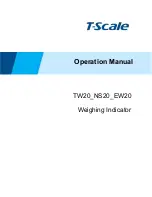
The Multi-Timbre Mode
The Multi-Timbre mode is a special mode in which the Personal
Electronic Piano voices can be independently controlled on
different MIDI channel numbers (1 through 10) by an external
MIDI device such as the Yamaha EMQ-1 Memory Box.
CHAN. VOICE CHAN. VOICE
1 PIANO 6 STRINGS
2 7
3
E.PIANO
8
P.ORGAN
HARPSI BASS
4 VIBES 9 PIANO
5 BRASS 10 PIANO
The Multi-Timbre mode can be activated as follows:
1. Hold down the MIDI/TRANSPOSE button.
2. Press the VIBES voice selector. If the VIBES LED is lit when
the VIBES voice selector is pressed, you have turned the
Multi-Timbre mode ON. If the VIBES LED is not lit when
the VIBES voice selector is pressed, you have turned the
Multi-Timbre mode OFF.
3. Release the MIDI/TRANSPOSE button.
Here’s an example of how you could
use
the Multi-Timbre
mode to record three different parts on the EMQ-1 Memory
Box that will play different voices on the Personal Electronic
Piano when played back.
1. Connect the EMQ-1 to the Personal Electronic Piano as
shown below.
2. Select the first voice and MIDI transmit channel number,
then record the first part on the EMQ-1.
3. Activate the Personal Electronic Piano Multi-Timbre mode,
then select a new MIDI transmit channel and voice and record
the second part on the EMQ-1 using its overdubbing function.
4. While still in the Multi-Timbre mode, select the third MIDI
transmit channel and voice and record the third part on the
EMQ-1 using its overdubbing function.
5. Still in the Multi-Timbre mode, play back the EMQ-1. The
recorded parts will be played back using the individual voices
selected during recording, providing a full ensemble sound.
The Split & Left Local OFF Mode
In the split mode one section of the Personal Electronic Piano
keyboard is used to play a Personal Electronic Piano voice in
the normal way, while the remaining section is used to play a
second MIDI keyboard or tone generator such as the Yamaha
EMT-1 FM Sound Box or EMT-10 AWM Sound Box. In this
mode the right-hand section of the keyboard is used to play
an internal Personal Electronic Piano voice, while the left-hand
section of the keyboard plays the external keyboard or tone
generator. Playing the left-hand section of the keyboard pro-
duces no sound from the Personal Electronic Piano. The “split
point,” or the key that divides the left- and right-hand sections
of the keyboard, is automatically set at F#
2
.
The split mode is useful if, for example, you want to play a
piano (Personal Electronic Piano) voice with the right hand
while playing a synthesizer bass line or string section with the
left hand.
When the split mode is activated, notes played on the left-
hand section are transmitted via the Personal Electronic Piano
MIDI OUT connector on MIDI channel 2. Notes played on the
right-hand section are transmitted on the “basic channel” (i.e.
the channel set using the MIDI channel selection function des-
cribed previously). Damper pedal data is sent via both channels.
12
Activating the Split & Left Local OFF Mode
1. Hold down the MIDI/TRANSPOSE button.
2. Press the STRINGS voice selector. If the STRINGS LED is
lit when the STRINGS voice selector is pressed, you have
turned the Split & Left Local OFF mode ON. If the STRINGS
LED is not tit when the STRINGS voice selector is pressed,
you have turned the Split & Left Local OFF mode OFF.
3. Release the MIDI/TRANSPOSE button.
The Split & Right Local Off Mode
In the YPP-50 either the right- or left-hand section of the key-
board can be assigned to control an external keyboard or tone
generator. Assigning the left-hand section to external tone gener-
ator control was described in the previous section. To assign
the right-hand section to external tone generator control while
playing the Personal Electronic Piano voices with the left hand,
press the BRASS voice selector instead of the STRINGS voice
selector when activating the Split mode (See “Activating the
Split & Left Local OFF Mode” in the previous section). All
other operations are exactly the same as described in the pre-
vious section.
Transmitting the Panel Settings
This function causes all the current Personal Electronic Piano
control settings (selected voice, etc) to be transmitted via the
MIDI OUT terminal. This is particularly useful if you will be
recording performances to a MIDI sequence recorder* which
will be used to control the Personal Electronic Piano on play-
back. By transmitting the Personal Electronic Piano panel set-
tings and recording them on the MIDI sequence recorder prior
to the actual performance data, the Personal Electronic Piano
will be automatically restored to the same settings when the
performance is played back.
*
The Yamaha EMQ-1 Memory Box automatically receives and
records the Personal Electronic Piano panel settings when a record-
ing is begun, so this function is most useful with MIDI sequence
recorders other than the EMQ-1.
1. Hold down the MIDI/TRANSPOSE button.
2. Press the P.ORGAN voice selector.
3. Release the MIDI/TRANSPOSE button.
Summary of Contents for YPP-50
Page 5: ...3 ...
Page 7: ...5 ...
Page 19: ...YAMAHA YAMAHA CORPORATlON P O Box 1 Hamamatsu Japan 909 VI27370 Printed in Japan ...





































